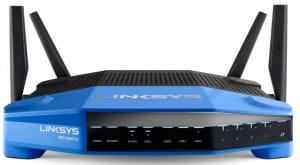Reboot your Router
 Reboot your Router: a reader asks…
Reboot your Router: a reader asks…
I’ve been reading in the news that I should reboot my router, and possibly do more stuff. Not sure what to believe these days or do. I have Verizon FIOS. Any advice?
At this point, my recommendation is along the lines of the FBI’s recommendation and reinforced by a Dept. of Justice notice: unplug electrical power from your router, wait 60 seconds and plug it back in. Given that this threat is ongoing, I expect that doing so at least once a week would be prudent for the near-term. In most cases, that is all you need to do. Folks with certain routers (Linksys, MikroTik, Netgear and TP-Link brands, but only specific models) were found to have been infected by the malware, but that’s mostly because the owner never changed the default password on their router.
 Some folks are recommending that folks also reset their routers back to factory specs (there’s a reset button on the router), and then re-configure it (changing the router password, wi-fi name and encryption passcode). For most consumers, that might be a daunting step. Many folks simply use the router provided by their Internet Service Provider (ISP, Verizon FIOS, Comcast/Xfinity, Cox, etc.), and are really dependent on that provider for service and updates. Others have purchased a 3rd party router and set it up – those folks will at least be familiar with accessing the router (usually by pointing your web browser to http://192.168.1.1 or http://192.168.0.1). Of course you’ll need to log into the router’s Control Panel to do things like:
Some folks are recommending that folks also reset their routers back to factory specs (there’s a reset button on the router), and then re-configure it (changing the router password, wi-fi name and encryption passcode). For most consumers, that might be a daunting step. Many folks simply use the router provided by their Internet Service Provider (ISP, Verizon FIOS, Comcast/Xfinity, Cox, etc.), and are really dependent on that provider for service and updates. Others have purchased a 3rd party router and set it up – those folks will at least be familiar with accessing the router (usually by pointing your web browser to http://192.168.1.1 or http://192.168.0.1). Of course you’ll need to log into the router’s Control Panel to do things like:
- change the router access password from the default factory password to a strong password you make up
- change the SSID (name of the Wi-Fi network) from the default to one you can manage
- change the Wi-Fi encryption passcode to something that can’t be easily guessed
 I note that recent models of Verizon FIOS Quantum Gateway routers now come with a unique and strong control panel password, and strong encryption (and passcode key), so if you have that router you probably don’t need to do anything else other that perhaps reboot it weekly. The easiest way to reboot is the above unplug/replug procedure. You can log into your router (http://192.168.1.1 with the login name and password that’s on a sticker on the router), and then hunt around till you find the firmware update utility (Advanced menu, Firmware Upgrade entry which has a Check button and Force Upgrade button to use if there is new firmware available).
I note that recent models of Verizon FIOS Quantum Gateway routers now come with a unique and strong control panel password, and strong encryption (and passcode key), so if you have that router you probably don’t need to do anything else other that perhaps reboot it weekly. The easiest way to reboot is the above unplug/replug procedure. You can log into your router (http://192.168.1.1 with the login name and password that’s on a sticker on the router), and then hunt around till you find the firmware update utility (Advanced menu, Firmware Upgrade entry which has a Check button and Force Upgrade button to use if there is new firmware available).
If you’re not comfortable logging into your router and making changes, then just reboot your router at least once a week for the time being. Watch out for additional advisories from the authorities and/or your favorite trusted tech bloggers, who can let you know whether it’s time to do something else/more. Till then, don’t worry about this threat too much, your ISP is most likely on top of the situation and can do things to block the malware on their network and prevent it from infecting your router.
This website runs on a patronage model. If you find my answers of value, please consider supporting me by sending any dollar amount via:
or by mailing a check/cash to PosiTek.net LLC 1934 Old Gallows Road, Suite 350, Tysons Corner VA 22182. I am not a non-profit, but your support helps me to continue delivering advice and consumer technology support to the public. Thanks!






